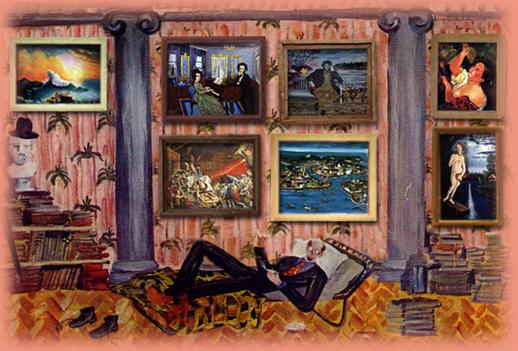"Many years ago, - reminds the painter Tatiana Mavrina, - I've seen in Sarapul on the Kama-river bank a half-destroyed merchant's house. Its walls, ceilings, doors - every surface was decorated with the copies of well-known paintings: "Boyars' Feast" by Makovsky, "May Night" by Kramskoy and others - it was a fantasy of the local amateur painters and an eccentric merchant".
Copying of samples is one of the necessary stages in the progress of naive artist. Copying could be a part of the artistic training process, which might enable an artist to develop his individual manner or it could be a special kind of artistic approach. It is most vivid in the portraits done after photographs. Naive artist has no fear looking and interpreting "a top" model. When he studies the original painting he is whirled by emotions and this feeling fills and transforms the copy.
Somehow it's a kind of interpretation of the original work of art into another artistic language: space looses its depth, compositional scheme becomes simpler, the contrasts of colour are more vivid, expressiveness of poses and motions comes to extreme. Misbalance of the accents gives birth to a new aesthetic system - that of the primitive art.
Naive painter usually chooses the works presenting some important events (important from the point of view of the painter with the archaic type of mentality based on the archetypes). A scene depicted by a classical painter somehow is forwarded to another dimension - to the world of the naive painter.
Metamorphoses would be quite natural here. Dark-skinned Italian girls are converted into "blood and milk" young girl with pink cheeks, whereas Botticelli's Venus is swimming in the spring at a calm Ukrainian night. Sometimes the copied scene might acquire more expressiveness than the original painting and the artist and spectators would get fascinated on their turn. Having been "interpreted" into the language of the primitive art, the classical model could be transformed into a new work of art belonging to another author.

